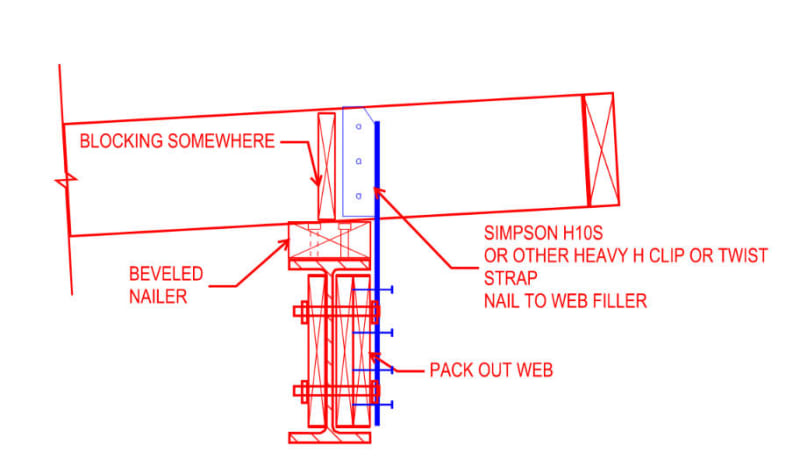Edward99
Structural
- Jan 30, 2024
- 3
Hello All,
I am new to the eng-tips forum, and I am a relatively new engineer in training.
I am working on the structural design of a commercial office building. Refer to the attached PDF to view the structural model (in progress) for context.
As you will see, the entrance features a slopped roof with LVL roof joists that overhang over the front elevation (approx. 1.8 m overhang). The overhang is needed for a large soffit assembly that was added by the architect for aesthetics.
In the current configuration, the roof joists bear directly on a steel beam in the front elevation wall (see attached PDF). I've analyzed the joists as pin-pin (with the perpendicular steel beams as supports) with an overhang as shown. I've also taken into account the snow drift load that will form due to the higher performance wall.
I am concerned about the joist-to-beam connection at the overhang area (highlighted in yellow in the PDF). I’ve calculated a large upward reaction force at this location. I'm uncertain about the ideal connection for this, it might need a more specialized connection than a standard hurricane tie. I would appreciate any thoughts or suggestions regarding the overall configuration and the type of connection that would ensure stability.
Thank you for your help.
I am new to the eng-tips forum, and I am a relatively new engineer in training.
I am working on the structural design of a commercial office building. Refer to the attached PDF to view the structural model (in progress) for context.
As you will see, the entrance features a slopped roof with LVL roof joists that overhang over the front elevation (approx. 1.8 m overhang). The overhang is needed for a large soffit assembly that was added by the architect for aesthetics.
In the current configuration, the roof joists bear directly on a steel beam in the front elevation wall (see attached PDF). I've analyzed the joists as pin-pin (with the perpendicular steel beams as supports) with an overhang as shown. I've also taken into account the snow drift load that will form due to the higher performance wall.
I am concerned about the joist-to-beam connection at the overhang area (highlighted in yellow in the PDF). I’ve calculated a large upward reaction force at this location. I'm uncertain about the ideal connection for this, it might need a more specialized connection than a standard hurricane tie. I would appreciate any thoughts or suggestions regarding the overall configuration and the type of connection that would ensure stability.
Thank you for your help.

